Proper tree care begins with selecting the right tree for North County San Diego and tree planting it in the right place to ensure the overall success, health, and beauty of your landscape. Tree Barber is dedicated to not only maintain your trees, but to also help establish them.
Tree Selection
There are a few things to consider when selecting a new tree for your landscape. The proper tree in the proper location will dictate whether or not the tree will survive.
▸Purpose
What is the intended purpose of your new tree? Start by deciding the purpose for your new tree such as appearance, privacy screening, shade, etc. Your decision will impact the ideal choice of all the different trees you may find at your local nursery.
▸Location
You have to consider the constraints of the location you want to plant your new tree in to ensure its health and limit potential damage. In order for most trees to flourish, they will need plenty of sunlight, nutrient-rich soil, and opportunities to soak up plenty of water. These factors are absolutely essential when determining ideal locations to plant a tree.
Use a measuring tape to measure out the location’s recommended radius where you want to plant your tree to ensure it will fit. Root systems on large trees are strong, and if you plant your trees too closely to buildings, sidewalks, concrete, or other structures, the roots may break them apart as they get larger.
Larger trees should never be planted under utility lines. You should be aware of the root structure of the new trees. Trees with invasive root structures near buildings, pavement, underground utilities, etc., can often cause expensive damage.
Contact your local power, water, and gas companies before you dig a spot to plant your tree. There may be cables, wires, and pipes buried in your yard, and you run the risk of serious injury or costly repairs if you cut into one of these while digging. Each utility should be willing to come out free of charge and mark off where its equipment is located.
▸Hardiness Zone
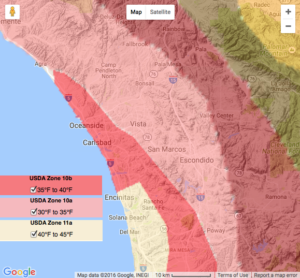 Your location has a tremendous impact on what trees will grow. Purchasing trees specific to your hardiness zone is imperative for the tree to survive. The map below shows the hardiness zones in North County. The zones reflect the minimum temperature your trees can endure, which is an average of 35°F to 40°F.
Your location has a tremendous impact on what trees will grow. Purchasing trees specific to your hardiness zone is imperative for the tree to survive. The map below shows the hardiness zones in North County. The zones reflect the minimum temperature your trees can endure, which is an average of 35°F to 40°F.
▸Size of the Mature Tree
Overhead wires will limit the height of the mature tree so you will want to select a shorter tree. Make sure you are aware of the size the tree will be at maturity. The chart below is a great representation of the range of heights of tree species.
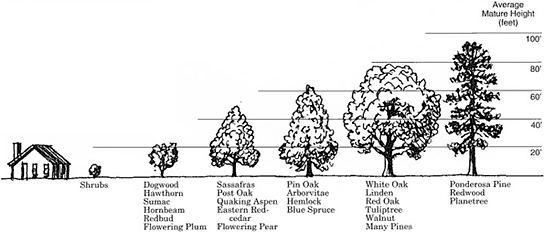
▸Sun Exposure
The sun exposure in your planting area will greatly affect how your tree grows.
Full Sun – Full sun means 6 full hours of direct sunlight. Those six hours could be from 8 – 3 or 12 – 6; anytime during the day. These hours can also be three morning hours, plus three afternoon hours.
▸Soil Condition
Some trees can grow in only specific types of soil, while others can grow in almost any condition the type of soil. Determining what type of soil you have in your yard will help you find the right tree. To learn what type of soil your yard has, you can schedule a consultation with our Certified Arborist, Paul Rider.
Basic Tree Care Maintenance
Upkeep on your trees can be fairly simple if you know what you’re doing. The most important factors are protecting your trees with mulch and fertilizers, proper watering and professional maintenance. Below are a few tips and information on the basics of caring for your trees.
▸Mulching
A newly planted tree’s best friend is mulch. It is very important to remember to mulch a newly planted tree in addition to maintaining the health and stability of your mature trees. Tree Barber can deliver free mulch directly to your house, depending on availability and location.
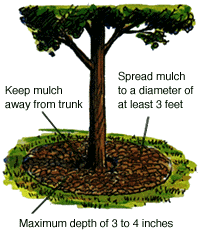
Mulch is important for several reasons including:
•Insulating the soil helping to provide a some protection from heat and cold.
•Retains water which helps to keep the roots moist.
•Keeps weeds out to help prevent root competition.
•Prevents soil compaction.
Adding Mulch Around Your Tree
•Add mulch to the base of your tree by removing any grass within a 3 to 10 foot area depending on the size of your tree.
•Pour natural mulch such as wood chips or bark pieces 2 to 4 inches deep within the circle.
•Keep the mulch from touching the trunk of the tree.
▸Watering
Properly watering your trees is a key part of tree care and it is difficult to recommend an exact amount due to the varieties of climates. North County San Diego is in a severe drought, so choosing drought resistant trees may be necessary. There are a few guidelines that will help you to water your trees properly.
Watering Newly Planted Trees
For new trees, water immediately after you plant a tree. To know the proper watering may require a professional native to your area.
Watering Trees During First Two Years
During the first couple growing seasons, your newly planted tree is expending a lot of energy trying to get its roots established in the soil. Especially during the first few summers of your new trees life, it will have a difficult time dealing with heat and drought. You can make this easier by providing water and covering the soil with mulch. Deep watering can help speed the root establishment. Deep water consists of keeping the soil moist to a depth that includes all the roots.
Amount of Water and Watering Schedule
Not enough water is harmful for the tree but too much water is bad as well. Over-watering is a common tree care mistake. Please note that moist is different than soggy, and you can judge this by feel. A damp soil that dries for a short period will allow adequate oxygen to permeate the soil.
As general rule, your soil should be moist. Usually 30 seconds with a steady stream of water from a garden hose w/ a diffuser nozzle per tree seedling is sufficient. Mulching is also key in retaining moisture in the soil.
You can check soil moisture by using a garden trowel and inserting it into the ground to a depth of 2″, and then move the blade of the trowel back and forth to create a small narrow trench. Then use your finger to touch the soil. If it is moist to the touch, then they do not need water.
Watering Trees After the First Two Years
After your tree has been established in your yard for two years the roots will be established. This will allow your tree to withstand a wider range of water conditions including on its own because it has a proper root structure.
Drought-Tolerant Species
If your area constantly deals with drought you will want to consider trees listed as drought-tolerant. These trees are adapted to sites in their native habitat that regularly experience prolonged dry spells. Although they are native to drought and are more tolerant than others the first few years of life is critical to the survival of the any tree and follow the steps above will help your trees grow. Click here to see our page on ideal choices of drought-tolerant trees perfect for North County San Diego.
Tree Pruning
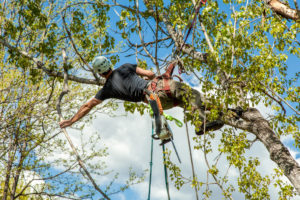 Professional pruning such as tree trimming, lacing, reduction, and more will effectively help to maintain your trees shape, appearance and overall health.
Professional pruning such as tree trimming, lacing, reduction, and more will effectively help to maintain your trees shape, appearance and overall health.
Improper pruning can create lasting damage or even shorten the tree’s life and can create lasting damage to both the tree and to your property. Pruning must be done with an understanding of tree biology by a qualified Certified Arborist.
▸When to Prune
This depends to a large extent on why you prune. Most routine pruning can be done at any time during the year, especially with the more subtle seasonal changes in North County San Diego.
Although there are general guidelines on the ideal time to prune, the health of the specific tree depends on whether pruning is in the best interest of the tree. A Certified Arborist should assess your trees to determine the proper time for pruning regardless of the season. However, there are some general guidelines that might help you to decide when it’s time to call a professional.
Winter Pruning
Pruning during dormancy is the most common practice. It results in a vigorous burst of new growth in the spring and should be used if that is the desired effect. It is usually best to wait until the coldest part of winter has passed. Some species, such as maple, walnuts and birches, may “bleed”—when the sap begins to flow. This is not harmful and will cease when the tree leafs out.
Summer Pruning
To direct the growth by slowing the branches you don’t want; or to slow “dwarf” the development of a tree or branch, pruning should be done soon after seasonal growth is complete. The reason for the slowing effect is that you reduce the total leaf surface, thereby reducing the amount of food manufactured and sent to the roots. Another reason to prune in the summer is for corrective purposes. Defective limbs can be seen more easily, or limbs that hang down too far under the weight of the leaves.
Pruning Flowering Trees to Enhance Flowering
For trees that bloom in spring, the best time to prune is when their flowers fade. Trees and shrubs that flower in mid- to late summer should be pruned in winter or early spring.
▸Keys to Good Pruning
Yearly pruning, pruning of big trees and any major pruning should only be done by a professional arborist but there are some tips for basic pruning in between your professional pruning. For proper pruning use the ⅓ and ¼ Rules of Pruning:

•Never remove more than ¼ of a tree’s crown in a season
•Ideally, main side branches should be at least ⅓ smaller than the diameter of the trunk.
•For most deciduous (broadleaf) trees, don’t prune up from the bottom any more than ⅓ of the tree’s total height.
•Where possible, try to encourage side branches that form angles that are ⅓ off vertical that form “10 o’clock” or “2 o’clock” angles with the trunk.
•For larger branches, cut outside the branch bark and ridge collar (swollen area). Do not leave a protruding stub. If the limb is too small to have formed a collar cut close.
•When simply shortening a small branch, make the cut at a lateral bud or another lateral branch. Favor a bud that will produce a branch that will grow in desired direction (usually outward). The cut should be sharp and clean and made at a slight angle about ¼ inch beyond the bud.
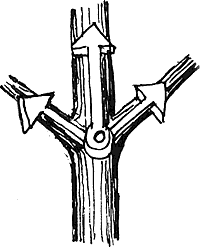
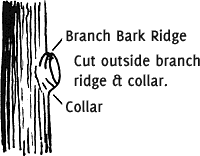
Want to Know More? Contact Us Today
Contact our experts at Tree Barber today at 760.745.7871. We are your tree and plant health professionals, and we will always value the beauty, safety, and long-term health of your trees.
We are proud to help customers in and around North County San Diego, including the communities of Carlsbad, Del Mar, Encinitas, Oceanside, Escondido, Bonsall, Fallbrook, Poway, Rancho Bernardo, Rancho Penasquitos, Rancho Santa Fe, San Marcos, Solana Beach, and Vista.
